- Home
- John Norman
Norman Invasions Page 6
Norman Invasions Read online
Page 6
The sky was dark now and he could see the bus below, white with a red stripe. The guide was there. The driver had come out. Two of the passengers, too, who would smoke. But it was not a stop for such. The guide, the driver, waved for him to come back.
There was smoke and fire behind him, from the hill fort, from the house of his father.
He had sprung from her side, from the softness of her, and the smell, and the dampness of the touching.
“I will tell him his name,” she called after him.
There had been a great four-legged beast, a horse. He had heard of these things. At the pommel of the saddle, tied there by the hair, he had seen his father’s head.
For one instant the eyes had looked at him.
The luck of the house he had seized, and, with others, was seen.
It was then he, and others, had run.
“Come back,” they called to him, from below, from the highway, leading to the city.
He could see the men following, descending from the hill fort. He had seen the horseman.
On the top of he hill, he had put it.
The men were coming, the horseman, the others on foot.
They came upon him at the top of the hill. He saw the horse clamber to the top, slipping, the rider lurching in the saddle
“Die, whelp,” he heard, “last of the kin!”
How he, youngest of the kin of the clan Lachlin, so many, the last?
The hill fort was aflame.
“Where is it, where is the luck of Lachlin!” cried the horseman.
He had turned to flee and had heard the horse, hoofs striking hard in the dirt, behind him.
Then what he felt seemed no more than a sudden, sharp, cold wind at the back of his neck.
“I will tell him his name,” she had called after him.
He had not even heard the man dismount, or the others, afoot, coming up, to stand beside him.
The tour guide, and some others, were following him, slowly, up the hill.
He fell to his knees in a given place, and, with his bare hands, began to tear at the ground.
“What is it?” they asked.
He tore at the earth.
“Come back to the bus,” said the tour guide.
His fingers were bleeding.
Then he touched it, his fingers just touching the pommel, the knob, at the head of the hilt, and then the hilt, the blade wrapped in cloth, muddy, rotted, and torn, and he drew from the earth that great blade, with the long hilt, that blade to be wielded with two hands by a strong man.
“Aii, that cloth,” said the guide, seeing the muddy, tattered shreds, “that is the banner of the Lachlins.”
“The clan Lachlin disappeared more than four hundred years ago,” said the driver.
“The blade,” said the guide, “surely that is the luck of the Lachlins.”
“How did you know where to find this?” asked the guide.
“I put it here,” he heard himself say. “But it was long ago.”
The Hairbrush
(An essay in paleocosmetology)
One hears a great deal these days about child abuse.
Indeed, one gathers that frustrating a child, for example, prohibiting him from playing with matches in a haystack, may have serious consequences later on, as his maturation may have been jeopardized. On the other hand, a parent’s concern, or, at least, the possible concern of many parents, with the welfare of his offspring, may militate against permitting him to frolic unattended in the midst of flammable substances. The problem then is how to permit the child to grow, to enjoy, and profit from, a remarkable learning experience, to proceed to express himself as a miniature individual, and, at the same time, to keep him alive.
If the child is, say, seventeen or eighteen, one may reason with him, pointing out the personal hazards involved, and the attendant social hazards, how much he means to his parents, for example, and how his siblings, and cousins, and friends, and the community, and so on, would miss him, and how any funeral expenses would have to be taken from his allowance, and such, and thus, by shrewd ratiocination, appeal simultaneously to a variety of interests, for example, to his instinct for self-preservation, social and civic responsibility, and greed. But, what if the child is not yet at the age of reason, and is discovered sitting in the haystack, beaming up at you, holding his first lighted match?
In my day, a primitive and benighted era, we would promptly remove the child from the haystack and extinguish the match. Indeed, we might even speak crossly to child, and might even warm his little stern for him. To be sure, this behavior might today land one behind bars.
But even the modern parent is unwilling to see his moppet immolated.
Accordingly there are a number of alternatives at his disposal. The most obvious is to anticipate the situation and be prepared for it, outfitting the tyke with protective gear, for example, with fire-proof gloves, an enclosed helmet, and an asbestos suit. If one cannot afford an asbestos suit, and such, perhaps having spent the money on the legally required car seat for his eighteen-year-old sibling, one might remove the haystack from the child, which will be less traumatic, apparently, than removing the child from the haystack, stand ready with a fire hose, have the haystack placed beneath a water tank which can be drained at a moment’s notice, lure the child away with a new puppy or ice cream, and so on.
Still there are dangers.
I leave these cheerfully, however, to our new generation of child psychologists and social workers.
This paper is addressed, rather, to a quite different, but, I think, interesting question.
How is it that the human race got to be the human race?
How did we get here without our child psychologists and social workers? How did the little tykes make it so far with so little help?
Interestingly enough a new study has appeared which bids fair to illuminate this knotty problem in evolutionary theory.
And it has to do with the simple hairbrush.
Many were the dangers which confronted our paleolithic ancestors, for example, cave bears, saber-tooth tigers, rogue mammoths, careless mastodons, not watching where they were going, other paleolithic ancestors, and so on. The human race, for better or for worse, had taken its leave of other primate species, which probably did not mind its departure, and opted for cunning, grumpiness, and home-made equipment, stone knives, axes, and such, thus enabling it to have at its disposal the means whereby, if suitably employed, it might eventually produce its own extinction, an advancement generally eschewed by more survival-oriented life forms. One must understand that things in those days were nip and tuck, though perhaps less so than in our day. Would the human race survive? What would evolution have to say about us? And what might we say about evolution? Could the genetic lotteries be rigged?
But back to the hairbrush.
It is well known that baby guppies, newly born fruit flies, freshly hatched crocodiles, and such, arrive in this world well-equipped to fend for themselves. Not so, of course, the newly delivered human infant. Mostly it just lies about and makes a great deal of noise. At birth, and for a good while thereafter, it is unable to lift a stone club, track a rabbit, or pounce on squirrels, let alone spear mammoths or contest real estate with large animals. But the precariousness of the human infant is well known. It was never doubted by even medium-sized predators. We may suppose that those mothers who followed the example of, say, the maternal crocodile, either letting the infant shift for itself, or eating it, did not find their genes frequently replicated. Thus, certain sorts of mothers, nurturing mothers, say, would be favored by evolution. Still the child was at great risk, and thus, obviously, so, too, was the human race.
One danger to the race which has hitherto received little attention is the risk involved in socialization.
Socialization, you see, though this has been seldom noticed, is replete
with its own perils.
Obviously the child must be socialized, taught to grunt, and such. Food is to be placed in the mouth and not the ear. One does not romp with tigers. One should treat others nicely, particularly if the others are enormous and ill-tempered. One should be careful where one throws one’s spears and shoots one’s arrows. And, if the group is sufficiently advanced, and has mastered fire, one should not set fire to one’s fellow tribesmen, and so on.
But this socialization, which must be achieved for group flourishing, and perhaps even group survival, also, interestingly, poses a dire threat to the very existence of the group itself.
But more of this anon.
Let us appear to digress briefly now, before suddenly revealing a plethora of startling connections and relationships which will astonishingly reveal that a seeming digression actually betokened a subtle fact of such moment that the very survival of the human race was contingent upon it.
It is recognized that your average human being is relatively hairless, compared, for example, to your average baboon or orangutan. Whatever the advantages of bipedalian hairlessness might be, in, say, avoiding overheating in the pursuit of antelope, one may well imagine the horror of hirsute parents upon discovering that some of their offspring were, in effect, born naked. Imagine the misery of relatively hairless young females poignantly observing their troubling reflections in merciless, reproachful pools of still water. What self-respecting baboon or orangutan could take them seriously? Was this some tragic genetic drift, like the ever-larger canines of the saber-toothed tiger which might end up doing little more than allowing the poor, doomed beasts to lacerate their own jaws? Clearly such biologically short-changed maidens would be of little interest to your average hairy swain. They must watch sadly while their more hirsute sisters were caught in the bushes or dragged to the back of caves.
Accordingly, as your average male could not overcome his disgust at the very appearance of a hairless female, and could soon see through the artifices and subterfuges of false hair, feathers, and such, he routinely chose hanging out with the boys, leaping off cliffs, or devoting himself to the service of, say, the bear god, who preferred to keep down the number of human beings, thus reducing the competition for desirable caves. So human males, rather than mate with hideously hairless members of the opposite sex, in one way or another, opted for a smug, fastidious celibacy, that in preference to a life of connubial revulsion.
And thus the numbers of humankind began to dwindle alarmingly, at least from its own point of view if not from that of other life forms.
Return now to the dangers of socialization.
There are obvious fads or fashions in many human endeavors, and such was the case, as well, in the paleolithic times now under consideration. The standard theory at the time among the child psychologists and social workers of the day, as can be made out from rock carvings, cave paintings, and such, was, in effect, “Spare the club and spoil the child.” Many is the carving or painting showing a tyke in mischief being approached by an adult bearing a large club. The club then descends rapidly and squarely, and the little tyke, we gather, from his prone position, has learned his lesson, and is certainly unlikely to repeat his behavior. Now, clearly, striking the small child heavily on the head with, say, a large rock or a stout club does tend to reduce the likelihood of the child’s repeating the disapproved or unacceptable behavior, but, too, obviously, it reduces considerably the likelihood, as well, of his eventually replicating his genes.
It is here that two evolutionary currents converge, to postpone, at least for a time, the imminent extinction of the human race.
And the humble hairbrush is implicated in this fortuitous sociobiological confluence.
A wise old woman, one supposes, for such seem most likely to track such cultural currents, noted that the numbers of extant children tended to decrease from month to month. It then occurred to her that if the blows administered by the instrument of discipline, the rock or club, were suitably cushioned in some way the children, statistically, would be more likely to survive, and the tribe might then make use of them in their maturity, for, say, spearing mammoths and bringing the meat home. We do not know how she came to this insight, but one might suppose that she herself had once, in her hairless youth, perhaps in pursuing a fleeing male, been surprised by, and cuffed by, a cave bear. Perhaps she should have known better than to have pursued a devotee of, or priest of, the bear god. In any event, she survived, with little more than a severe headache and a few claw marks. Had she been struck by the fleeing male’s club, on the other hand, she might have had to put aside forever her hopes of winning his favor. At her instigation, several of her tribesmen, fearing, perhaps because of the claw marks, that she might be a witch, began to wrap fur about their disciplinary rocks and clubs. This act was regarded as a concession to decadence by the child psychologists and social workers of the day, but, statistically, more and more children survived, and the innovation began to catch on.
A wise old man, then, one supposes, for such seem most likely to track such cultural currents, began to note that the surviving female children, particularly those who managed to make it past puberty, began to look better and better to him, for their hair, now, was no longer the unkempt brushy tangle of yesteryear, loaded with twigs, leaves and lice, but was now long, silken, and glossy, a veritable pelt. He pondered long on these things and the matter was decided for him when a number of baboons and orangutans surprised and began to accost, in a vulgar manner, a number of village maidens innocently bathing in a nearby pool. As in those days mature, healthy, sexually normal male baboons and orangutans served as the arbiters in such delicate matters it was made clear to the old man, and others, that the tribal maidens had passed a severe test. If they could be of interest to judges so discriminating and able what mere human being, particularly one without a great deal of hair, would have the temerity to challenge a verdict so perspicacious and authoritative? In any event, many of the young males began to reduce their time with the boys and the number who flung themselves from cliffs in despair also declined. Similarly, the bear god now began to languish for devotees and priests and had to look more closely to the protection of his caves.
And the tribe began to increase.
And not only, of course, were the young human females now redeemed by, and enhanced by, their long, glossy hair, which they tended to dress and care for with great attention and vanity, when not fighting off the advances of males of a variety of species, but many of the young males, as well, now appeared better groomed than hitherto, and this fact was not long left unnoted by the pursued and appetitious maidens, whose rate of speed now tended to be correlated with the attractiveness of the pursuer.
It was thus that two sociobiological currents converged, fortunately for the human race. First, socialization, or child training, no longer, in most cases, constituted a hazardous time for youth, and a shift in aesthetic tastes took place, as well, from the lumbering, shaggy female to the graceful, quickly moving, but no more quickly moving than necessary, sexy, shapely, largely hairless but nonetheless beautifully pelted female.
It might be noted in passing that the child psychologists and social workers of the day now began to recommend cushioned disciplinary devices to attentive, concerned parents. The motto was still “Spare the club and spoil the child,” but it was now understood that the club would be cushioned.
This, then, is the story of the hairbrush, how it came to be, and how, interestingly, we owe to this small and humble artifact the very survival of the human race.
It is rumored, incidentally, that in certain backward homes, in primitive areas, the hairbrush is still used as a disciplinary device.
Bamohee
Yes, bamohee.
That is the word, bamohee.
It may sound to you like a mere colligation of meaningless syllables, So, too, did it to me, once.
I first heard this word from m
y grandson, Thomas, who was verging on three at the time. That is, approximately, as I have later discovered, the bamohee time, that is, the time in which that unusual combination of syllables, the mighty, pregnant “bam,” the arresting, startling “oh,” hinting of awesome, infinite wonder, and the sudden, devastating “hee” of insight and revelation, in a sudden synergistic burst of cognitive fury and illumination unlock the meaning of a species, the mysteries of time and space, the secrets of the universe and the riddle of being itself, itself.
But allow me to begin at the beginning, as far as these things have a beginning.
First, as far as I know, no other animal species says bamohee. It seems idiosyncratic to the human species. There is no record of its utterance, at least insofar as I am aware, by any other mammal, the cat, the horse, the dog, the mongoose, and so on. It is true that it may be mindlessly repeated by certain unusual birds, most notably the gaudy, nut-savoring parrot, but, as far as we can tell, it carries no special significance for our avian friends. To them it seems a mere nonsense word, as far as we can determine. Certainly, when Polly beaks the syllables her beady eyes do not suddenly mist and glow, her claws do not clasp her perch with alarmed fervor, her feathers do not lift, ruffle, and shudder with ecstasy, no more than when she says ‘kitchen sink’ or ‘vacuum cleaner’, two of her favorites, though lagging far behind the communicative “I want a cracker, stupid.”
At one time, shortly before his third birthday, Thomas began to say bamohee frequently. It seemed to be a universal word, which might have stood for almost anything, a cookie, the neighbor’s dachshund, a soiled diaper, the binomial theorem, anything. How naive we were!
Thomas would approach his parents with all the love, trust, and sincerity of a child raised as he was, raised in such a manner as to expect the best and noblest of the world into which he would soon be precipitated, a world he would soon discover, alas, as do we all, not designed expressly for his benefit. But the bamohee time of youth precedes normally the period of being pelted and punctured with “the slings and arrows of outrageous fortune.” The lacerations and bruises of existence, at the bamohee time, lie around the corner, far from the crib and that mysterious, inexplicable artifact in the parents’ bathroom, the potty chair. Thomas would approach his parents, look at them earnestly, and say, “Bamohee.” Bamohee, of course, is not the first word a child is likely to say. That word seems to be “No,” at least in English and Spanish, “Non” in French, “Nein” in German, “Nyet” in Russian, and so on. To be sure, “No” is often followed by another word, for example, “No, Mama,” “No, Dada,” and so on. It seemed as though Thomas, in his innocence, with his fresh view of the world, was honestly interested in communicating something, in telling his parents something, something important, that he was benevolently interested in sharing something with them, something which they might find of great significance, but they, alas, representatives of the insouciant, careless generation, so unlike that of their own parents, depression children, that splendid generation, mine, honed to nobility by sacrifice, tutored in adversity, brought to greatness by paucity, took little note of Thomas’ offer. Rather they tried to distract him from bamohee, and lure him into the groves of ‘kitchen sink’ and ‘vacuum cleaner’, countries which might be trod even by ill-tempered parrots. If they had only listened. You see, the bamohee time is brief. It seems to be a tide which comes but once in a child’s life. Its gift might have been immeasurable.

 Avengers of Gor
Avengers of Gor Kajira of Gor coc-19
Kajira of Gor coc-19 Mercenaries of Gor coc-21
Mercenaries of Gor coc-21 Witness of Gor coc-26
Witness of Gor coc-26 Witness of Gor
Witness of Gor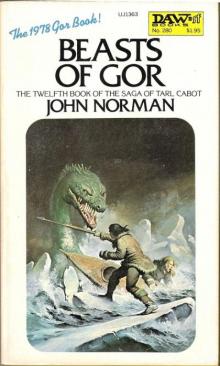 Beasts of Gor coc-12
Beasts of Gor coc-12 Rebels of Gor
Rebels of Gor Mariners of Gor cog[oc-30
Mariners of Gor cog[oc-30 The King th-3
The King th-3 Captive of Gor coc-7
Captive of Gor coc-7 The Captain th-2
The Captain th-2 Vagabonds of Gor coc-24
Vagabonds of Gor coc-24 Explorers of Gor
Explorers of Gor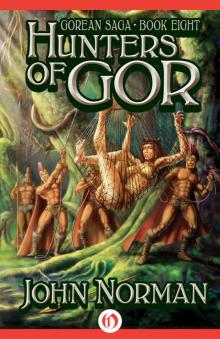 Hunters of Gor
Hunters of Gor The Chieftan th-1
The Chieftan th-1 Outlaw of Gor
Outlaw of Gor Priest-Kings of Gor coc-3
Priest-Kings of Gor coc-3 Norman Invasions
Norman Invasions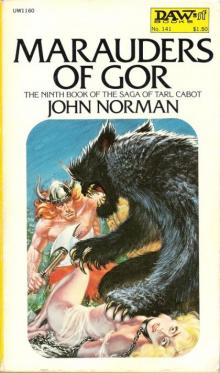 Marauders of Gor coc-9
Marauders of Gor coc-9 Kur of Gor coc-28
Kur of Gor coc-28 Time Slave
Time Slave The Chieftain
The Chieftain Kur of Gor
Kur of Gor Rogue of Gor
Rogue of Gor The Totems of Abydos
The Totems of Abydos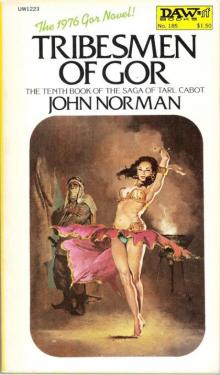 Tribesmen of Gor coc-10
Tribesmen of Gor coc-10 Renegades of Gor coc-23
Renegades of Gor coc-23 The King
The King Tarnsman of Gor
Tarnsman of Gor The Usurper
The Usurper Captive of Gor
Captive of Gor Conspirators of Gor
Conspirators of Gor Smugglers of Gor
Smugglers of Gor Savages of Gor
Savages of Gor Savages of Gor coc-17
Savages of Gor coc-17 Fighting Slave of Gor
Fighting Slave of Gor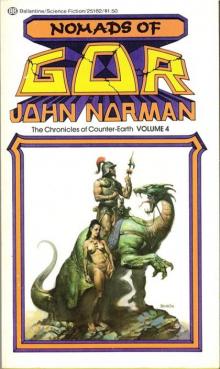 Nomads of Gor coc-4
Nomads of Gor coc-4 Fighting Slave of Gor coc-14
Fighting Slave of Gor coc-14 Swordsmen of Gor cog[oc-29
Swordsmen of Gor cog[oc-29 Priest-Kings of Gor
Priest-Kings of Gor Guardsman of Gor coc-16
Guardsman of Gor coc-16 Hunters of Gor coc-8
Hunters of Gor coc-8 Dancer of Gor coc-22
Dancer of Gor coc-22 Prize of Gor coc-27
Prize of Gor coc-27 Conspirators of Gor cog[oc-31
Conspirators of Gor cog[oc-31 Slave Girl of Gor
Slave Girl of Gor Explorers of Gor coc-13
Explorers of Gor coc-13 Assassin of Gor coc-5
Assassin of Gor coc-5 Raiders of Gor coc-6
Raiders of Gor coc-6 Tarnsman of Gor coc-1
Tarnsman of Gor coc-1 Dancer of Gor
Dancer of Gor Outlaw of Gor coc-2
Outlaw of Gor coc-2 Guardsman of Gor
Guardsman of Gor Beasts of Gor
Beasts of Gor Ghost Dance
Ghost Dance Nomads of Gor
Nomads of Gor Prize of Gor
Prize of Gor Rogue of Gor coc-15
Rogue of Gor coc-15 Swordsmen of Gor
Swordsmen of Gor